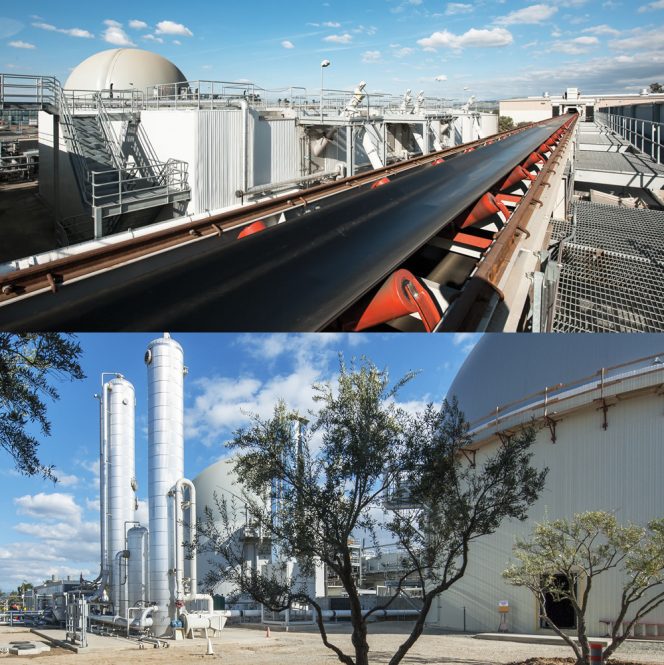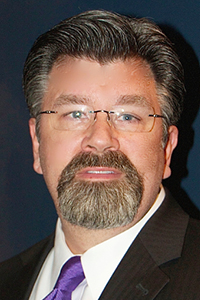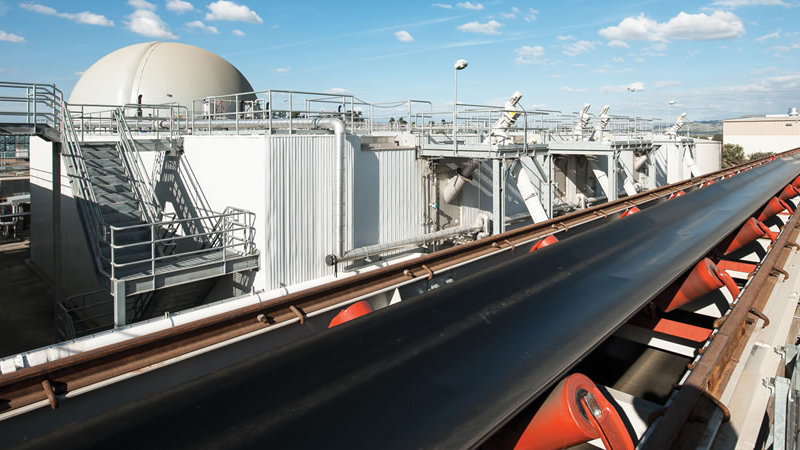The Integrated Biogas Alliance’s (IBA) founding Members are Eisenmann Corp. (Chicago, U.S.), Entsorga (Milan, Italy), Greenlane Renewables (Vancouver, Canada) and Tietjen (Hamburg, Germany). For combined heat and power (CHP), IBA’s Partner is AB Energy (Orzinuovi, Italy). More recently, Symbiont Science, Engineering and Construction, Inc. (Milwaukee, U.S.) — an EPC contractor (Engineering, Procurement, Construction) focused on renewable natural gas (RNG) and renewable energy projects — and Clean Fuel Partners (Madison, U.S.), anaerobic digestion (AD) operations and maintenance (O&M) specialists, joined IBA as Partners.

IBA founding Members include Eisenmann Corp. (digester technology shown in top photo) and Greenlane Renewables (biogas conditioning system shown above). Photos courtesy of CR&R Environmental Services
“With a combined 125 years of expertise and thousands of systems deployed around the world, the IBA brings together proven technologies into an integrated platform that can accommodate virtually any organic feedstock,” explains Christopher Maloney, President of the IBA, and Global Head of Organics Diversion at Eisenmann. “Our collective global deployment capability and supply chain enables IBA to tap into a broader pipeline of project opportunities around the world. Our technology platform includes either wet or dry AD and provide customers with multiple offtake opportunities including CHP for electric and thermal demand, RNG for pipeline injection or CNG for transportation applications, as well as multiple organic fertilizer options. IBA’s technological and commercial integration derisks a biogas project, ensuring both EPCs and investors early on that they have an integrated set of performance guarantees that will improve the project’s bankability as well as its long-term economic viability.”

Christopher Maloney
BioCycle CONNECT® Editor Nora Goldstein spoke with Maloney shortly after the IBA was announced to learn more about this “total solution” approach.
BioCycle: What is the state of the biogas industry and marketplace globally that creates this opportunity for the IBA?
Maloney: The answer to that question really has several components. First, the biogas industry is very fragmented, with a host of stakeholders vying for different pieces of the business. This includes a wide range of project developers trying to secure permits, grants, as well as feedstock and offtake agreements, who then typically either flip those projects for a fee or a carried interest in the project. You have farmers, waste haulers, EPCs, RNG offtakers, investor owned utilities, municipalities, renewable energy funds, technology companies — even oil and gas companies— out there chasing low carbon index cow manure-based projects. It’s like the wild west … all trying to identify project opportunities early enough to be able to influence a buying decision, or at least help shape the value proposition in their favor.
The particular challenge for technology companies is to competitively differentiate themselves — it is usually very difficult individually to be proactive on the front end of these deals as we are typically responding to an RFP from an EPC whose main goal is to drive the capital cost down. We believe the IBA model has a distinct advantage over a single equipment vendor, allowing us to get in earlier on a project because we can bring not only a totally integrated solution but can help the EPC shape the right solution for the customer at the beginning of the development process.
The other part of the answer is related to performance guarantees. As technology companies, we are all working independently to market our equipment and expertise. It dawned on me after a conversation with Greenlane Renewables CEO Brad Douville 2 years ago that one way to address the fragmentation in the market was not only to create a technically integrated platform of AD solutions but also develop a commercially integrated offering to address the performance guarantee issue, including biogas yield, which is always a challenge for an EPC with multiple vendors. At the end of the day, EPCs and lenders are primarily concerned about 3 things: CAPEX, ROI and performance guarantees. We believe the IBA provides critical risk mitigation for the lender.
BioCycle: Where does IBA see growth coming from in the next 5 years?
Maloney: Industry projections by international trade groups continue to increase the size of the market every 6 months or so, with some analysts putting the expected market value in total revenues at over $100 billion by 2025. By anyone’s measure the global market is huge and big enough for many companies to compete. For the IBA, it’s about continuing to focus where we know we can be successful — where there are strong and stable incentives, a good value to price balance and where we can leverage our collective relationships. North America, China, Southeast Asia, certain countries in Western and Eastern Europe and Latin America are all strong markets for us going into 2020. According to a recent report from the World Biogas Association (WBA), there are an estimated 132,000 industrial biogas plants operating around the world, employing some 350,000 workers, which may seem like a lot, but they are only processing roughly 2% of all available organic feedstocks. That leaves a lot of room for growth.
BioCycle: Don’t EPCs give up a lot by not being able to competitively bid the equipment for these projects?
Maloney: We don’t think so. Having an integrated solution using proven technologies with integrated performance guarantees outweighs any perceived disadvantage. Investors and their EPCs are interested in the “cycle time” to get a plant up and running and get to revenue — and having to go out to the market to solicit vendors, evaluate bids and negotiate separate contracts takes time. We believe the IBA can help them shorten this timeframe.
BioCycle: How do IBA Members differ from IBA Partners and how do they complement one another?
Maloney: The best way to think of it is the IBA Members are the integrated technology platform “hub” and the Partners are the “spokes” that provide project financing, construction, operations or in some way enhance our execution capability in different geographical regions. Also, IBA Members don’t compete with their technologies. This was one of the key principles of the founding companies in order for us to be transparent on a given project, which is critical to our commercial strategy.
BioCycle: IBA states that its fully integrated organic waste to renewable energy platform solution “derisks biogas projects for builders and makes the projects more competitive.” How is that achieved?
Maloney: This really goes to your earlier question but raises another important point for the EPCs. Many EPCs are not willing to provide a “performance wrap” for a biogas project without a premium — usually in the range of 8 to 12% of the total project cost to cover this risk. These “wraps” are risky for the EPCs because they have to go out to the market and competitively bid the equipment along with everything else, then put all these pieces together including the balance of the plant, engineering, etc. — and convince the investor that the project has been sufficiently derisked so they will finance it. Having an EPC like Symbiont involved in the integration of the technology platform is a real advantage for investors, making them more competitive by lowering the risk premium.
Learn more at ibabiogas.com.












